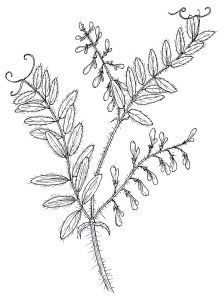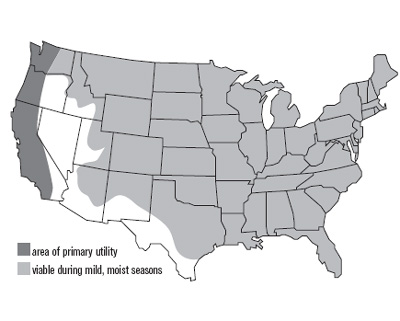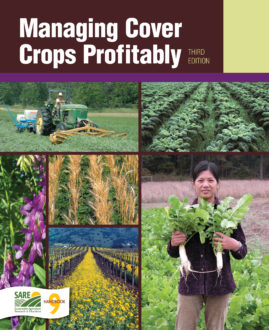
Woollypod Vetch (Vicia villosa ssp. dasycarpa)
Also called: LANA vetch; also spelled woollypod vetch
Cycle: cool-season annual
Type: legume
Roles: N source, weed suppressor, erosion preventer, add organic matter, attract bees
Mix with: other legumes, grasses
See charts, p. 66 to 72, for ranking and management summary.
Specialty vetches such as woollypod and purple vetch (Vicia benghalensis) are faster growing alternatives to hairy vetch (Vicia villosa) in Hardiness Zone 7 and warmer. Requiring little or no irrigation as a winter cover in these areas, they provide dependable, abundant N and organic matter, as well as excellent weed suppression.
Many growers of high-value crops in California rely on one or more vetch species as a self-reseeding cover crop, beneficial insect habitat and mulch. They can mow the vetch during winter and in late spring after it reseeds.
Some vineyard managers seed LANA woollypod vetch each year with oats or as part of a legume mix—common vetch, subterranean clover, a medic and LANA, for example. They plant the mix in alternate alleyways to save on seeding costs and reduce moisture competition, while ensuring sufficient cover that they can mow or disk. LANA’s climbing tendency (even more so than purple or common vetch) and abundant biomass can become problems in vineyards and young orchards, but can be readily managed with regular monitoring and timely mowing.
In Zone 5 and colder and parts of Zone 6, woollypod vetch can serve as a winterkilled mulch— or as a quick, easy-to-mow spring cover—for weed control and N addition to vegetable transplants. It’s a good choice as an overwintering cover before or after tomato crops in Zone 6 and warmer. In California, LANA provided the most N and suppressed the most weeds during two consecutive but distinctly different growing seasons, compared with purple vetch and other legume mixtures (413, 414).

Benefits of Woollypod Vetch Cover Crops
N Source. A first-year, overwintering stand of woollypod vetch easily will provide more than 100 pounds of N per acre in any system when allowed to put on spring growth. The popular LANA cultivar starts fixing N in as little as one week after emergence.
LANA can contribute as much as 300 pounds of N its first year or two, given adequate moisture and warm spring growing conditions (273, 396). Fall-planted LANA incorporated before a corn crop can provide a yield response equivalent to 200 lb. N/A, a California study showed (273). Similar results have been seen in tomato research in California (396). In western Oregon, a yield response equivalent to 70 lb. N/A for sweet corn has been observed (364).
Plenty of soil-building organic matter. Woollypod typically produces more dry matter than any other vetch. LANA shows better early growth than other vetches, even during cool late fall and winter weather in Zone 7 and warmer. LANA shows explosive growth in early spring in the Pacific Northwest (364) and in late winter and early spring in California when moisture is adequate. It can provide up to 8,000 lb. DM/A, which breaks down quickly and improves soil structure (63, 273, 396).
Frost protectant. Some orchard growers have found that keeping a thick floor cover before the blossom stage can help prolong a perennial crop’s dormant period by up to 10 days in spring.“ This reduces the risk of early frost damage (to the blossoms, by delaying blossoming) and lengthens the blossoming period of my almond trees,” notes almond grower Glenn Anderson, Hilmar, Calif.
Smother crop. Woollypod’s dense spring growth smothers weeds and also provides some allelopathic benefits. Of 32 cover crops in a replicated study at a California vineyard, only LANA completely suppressed biomass production of the dominant winter annual weeds such as chickweed, shepherd’s purse, rattail fescue and annual ryegrass (422).
Beneficial habitat. Woollypod vetch attracts many pollinators and beneficial insects. In some orchards, these beneficials move up into the tree canopy by late spring, so you can mow the floor cover after it reseeds and not worry about loss of beneficial habitat (184).
Management of Woollypod Vetch Cover Crops
Establishment & Fieldwork of Woollypod Vetch Cover Crops
Woollypod does well on many soil types—even poor, sandy soil—and tolerates moderately acidic to moderately alkaline conditions. It’s well-adapted to most orchard and vineyard soils in California (422).
It establishes best in recently tilled, nutrient deficient fields. Tillage helps enhance the reseeding capability of vetches (63). LANA woollypod vetch hasn’t done as well in some no-till systems as it was expected to.
Given adequate moisture, however, broadcasting LANA even at low to moderate rates—and with light incorporation—can give satisfactory results from fall seedings, especially if the stand is allowed to grow through mid-spring. If your goal is to shade out competition quickly, however, broadcast at medium to high rates and incorporate lightly.
You might not recognize the emerging plant without its characteristic multiple leaflets, says Glenn Anderson. “You should spot it within two weeks of planting, three at the latest, depending on temperature and soil conditions. Even at 6 inches, it’ll still look spindly. It won’t really leaf out until late winter and early spring, when more aggressive growth kicks in.” That may continue until maturity in mid- to late May.
Fall planting. Most growers seed at low to medium rates, regardless of seeding method. If drilling, 1/2 to 1 inch deep is best, although up to 2 inches will work for early seedings. If broadcasting, follow with a cultipacker or a shallow pass of a spike-toothed harrow.
Seedbed preparation is crucial for establishing a healthy cover crop stand in vineyards. California viticulturist and consultant Ron Bartolucci recommends making two passes with a disk to kill existing vegetation and provide some soil disturbance. He cautions against using a rotary tiller, which can pulverize the soil and reduce its waterholding capacity (211).
Bartolucci prefers to drill rather than broadcast cover crops, saving on seed costs and ensuring seed-to-soil contact. He recommends the economical, alternate row planting that also ensures easy access for pruning grape vines.
Don’t wait too long in fall to seed woollypod vetch in Zone 7 and warmer, however. If you wait until the soil starts getting cold, in mid-October in Oregon and early November in parts of central California, germination will be poor and the stand disappointing. Seed too early, though, and you miss the early moisture benefit of the Central Valley’s fog season and will need to irrigate more before the rainy season.
Regardless of your planting method, seed woollypod vetch into moist soil or irrigate immediately after seeding to help germination (273). If irrigation is an option but you want to conserve water costs, try seeding just before a storm is forecast, then irrigate if the rain misses you.
Spring planting. Planted in early spring, woollypod vetch can provide plowdown N by Memorial Day for a summer annual cash crop in the Northeast.
Mowing & Managing Woollypod Vetch Cover Crops
Woollypod vetch can survive freezing conditions for days, but severe cold can markedly reduce its dry matter and N production (212, 273).
In most cases, main challenges for an established woollypod vetch stand include managing its abundant growth and viny tendrils and ensuring adequate moisture for your primary crop. In wet environments such as western Oregon, however, LANA vetch can retard spring soil drying and seedbed preparation for summer crops (364).
Woollypod responds well to mowing, as long as you keep the stand at least 5 inches tall and avoid mowing during the two-month period just before it reseeds. “I can mow as late as mid-March and still see good reseeding,” says Glenn Anderson, an organic almond grower in California ’s Central Valley.“ After that, I may mow if I want to prevent some frost damage, but I know I’ll lose some of the vetch through reduced reseeding.”
Anderson usually mows the floor cover once or twice before mid-March and after it reseeds. He cuts in the direction of prevailing winds—which can be on a diagonal to his tree rows—to facilitate air movement throughout the orchard, especially when he anticipates moist air heading his way.
In vineyards, “high chopping” legume mixes to a 12-inch height can help keep them from trellising over vine cordons. In vineyards without sprinklers for frost protection, some growers incorporate legume mixes in spring, before the soil becomes too dry for disking. Where sprinklers are used, the covers might be allowed to grow for a longer period and provide additional N. Timing is important when disking, however, as you don’t want to make equipment access difficult or compact soil during wet spring conditions (211).
Given the high dry matter production from woollypod vetch when it’s allowed to grow at least until late March, two or three diskings or mowings will encourage rapid decomposition. Power spaders can reduce soil compaction when incorporating vetches in spring conditions, compared with heavier disk harrows (421).
Moisture concerns. Many orchard and vineyard growers find it helpful to drip irrigate tree or vine rows if they are growing an aggressive cover crop such as LANA between the rows for the first time. In California vineyards where irrigation isn’t used, a few growers report that vines seem to lose vigor faster when grown with cover crops. Others haven’t observed this effect. After a few years of growing leguminous covers, many find that their soil is holding moisture better and they need less water to make the system work.
Reseeding concerns. Vetch mixtures often fail to reseed effectively, especially if they have been mowed at the wrong time or soil fertility is high. Some vineyard managers expect low persistence and reseed a vetch mix in alternate rows every fall, or reseed spotty patches.
Regardless of mowing regime, LANA ’s persistence as a self-reseeding cover diminishes over time, and other resident vegetation starts to take over. That ’s a sign that the cover’s water-holding, fertility- and tilth-enhancing benefits have kicked in, says Glenn Anderson.
It’s natural to expect a change in the resident vegetation over time, observes Anderson. After a few years of reseeding itself—and providing abundant dry matter and nitrogen—the LANA he had clear seeded at low rates between orchard rows on half his acreage eventually diminished to about 10 percent of the resident vegetation, he notes. Subclovers and other legumes he introduced have become more prominent. Those legumes may have better self-reseeding capability than LANA, other growers note.
Pest Management with Woollypod Vetch Cover Crops
Woollypod vetch outcompetes weeds and will quickly resolve most weed problems if seeded at high rates. Woollypod also provides some allelopathic benefits. A root exudate can reduce growth in some young grasses, lettuces and peas, however.
Hard seed carryover can cause LANA to become a weed in subsequent cash crops and vineyards, however (102). Its strong climbing ability can cover grape vines or entwine sprinklers. In orchards, it s fairly easy to cut or pull LANA vines out of the canopy of young trees. Mowing or “high chopping” may be needed, especially in vineyards, even though this can reduce LANA ’s reseeding rate.
Insects pests aren’t a major problem with woollypod vetch, in part because it attracts lady beetles, lacewings, minute pirate bugs and other beneficials insects that help keep pests in check.
LANA can be a host of Sclerotinia minor, a soilborne pathogen that causes lettuce drop, a fungal disease affecting lettuce, basil and cauliflower crops. In a California study involving cover crops that were deliberately infected with S. minor, the pathogen levels were associated with higher lettuce drop incidence the summer after LANA had been incorporated, but wasn’t as problematic the following year. Woollypod vetch probably isn’t a good choice if you’re growing crops susceptible to this pathogen.
Other Options with Woollypod Vetch Cover Crops
Seed. Woollypod vetch is a prolific seed producer, but its pods are prone to shattering. You can increase seed harvest by raking the field (without mowing, if possible) to gather the crop into windrows for curing, before combining with a belt-type rubber pickup attachment (421).
Forage. Like most vetches, LANA is a somewhat bitter yet palatable forage when green, and the palatability increases with dryness (421). It is a nutritious forage for rangeland use (421).
For hay, it is best cut in full bloom. The leaves dry rapidly and swaths can be gathered within a day or two (421).
Comparative Notes
- Woollypod has slightly smaller flowers than hairy vetch, and its seeds are more oval than the nearly round seeds of hairy vetch. LANA also has a higher proportion of hard seed than hairy vetch (422).
- LANA shows more early growth than common vetch, although both increase their biomass dramatically by midspring.
- LANA and purple vetch are more cold-sensitive than common vetch or hairy vetch. Once established, LANA can tolerate early frosts for a few days (especially if the temperature doesn’t fluctuate widely or with some snow cover) and is hardier than purple vetch, which is more susceptible to early spring dieback (149).
- LANA flowers about three weeks earlier than purple vetch and has a better chance of setting seed in dryland conditions (273).
- LANA and LANA mixes suppress weeds better than purple vetch (149).
